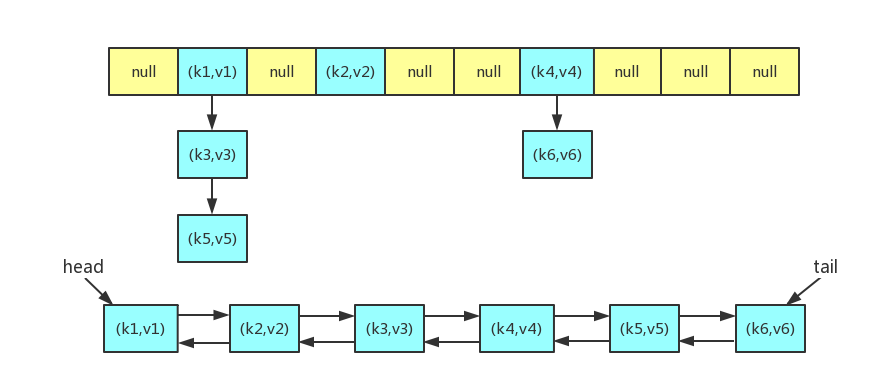概述
LinkedHashMap继承自HashMap,实现了Map<K,V>接口。其内部还维护了一个双向链表,在每次插入数据,或者访问、修改数据时,会增加节点、或调整链表的节点顺序。以决定迭代时输出的顺序。
默认情况,遍历时的顺序是按照插入节点的顺序。这也是其与HashMap最大的区别。
也可以在构造时传入accessOrder参数,使得其遍历顺序按照访问的顺序输出。
因继承自HashMap,所以除了输出无序,其他LinkedHashMap都有,比如扩容的策略,哈希桶长度一定是2的N次方等等。
LinkedHashMap在实现时,就是重写override了几个方法。以满足其输出序列有序的需求。
内部结构
LinkedHashMap的实现主要分两部分,一部分是哈希表,另外一部分是链表。

数据结构
//LinkedHashMap的链表节点继承了HashMap的节点,而且每个节点都包含了前指针和后指针, //所以这里可以看出它是一个双向链表 static class Entry<K,V> extends HashMap.Node<K,V> { Entry<K,V> before, after; Entry(int hash, K key, V value, Node<K,V> next) { super(hash, key, value, next); } } //双向链表的头指针 transient LinkedHashMap.Entry<K,V> head; //双向链表的尾指针 transient LinkedHashMap.Entry<K,V> tail; //默认是false,则迭代时输出的顺序是插入节点的顺序。若为true,则输出的顺序是按照访问节点的顺序。 //为true时,可以在这基础之上构建一个LruCach final boolean accessOrder;
构造函数
//指定初始化时的容量,和扩容的加载因子 public LinkedHashMap(int initialCapacity, float loadFactor) { super(initialCapacity, loadFactor); accessOrder = false; } //指定初始化时的容量 public LinkedHashMap(int initialCapacity) { super(initialCapacity); accessOrder = false; } public LinkedHashMap() { super(); accessOrder = false; } //利用另一个Map 来构建, public LinkedHashMap(Map<? extends K, ? extends V> m) { super(); accessOrder = false; putMapEntries(m, false); } //指定初始化时的容量,和扩容的加载因子,以及迭代输出节点的顺序 public LinkedHashMap(int initialCapacity, float loadFactor, boolean accessOrder) { super(initialCapacity, loadFactor); this.accessOrder = accessOrder; }
构造函数和HashMap相比,就是增加了一个accessOrder参数,用于控制迭代时的节点顺序,默认是false。
覆盖的方法
在HashMap中有三个模版方法,供子类来覆盖,在访问、插入、删除某个节点之后,进行一些特殊处理。
// Callbacks to allow LinkedHashMap post-actions void afterNodeAccess(Node<K,V> p) { } void afterNodeInsertion(boolean evict) { } void afterNodeRemoval(Node<K,V> p) { }
1. afterNodeAccess方法,会将当前被访问到的节点e,移动至内部的双向链表的尾部。
void afterNodeAccess(Node<K,V> e) { // move node to last LinkedHashMap.Entry<K,V> last;//原尾节点 //如果accessOrder 是true ,且原尾节点不等于e if (accessOrder && (last = tail) != e) { //节点e强转成双向链表节点p LinkedHashMap.Entry<K,V> p = (LinkedHashMap.Entry<K,V>)e, b = p.before, a = p.after; //p现在是尾节点, 后置节点一定是null p.after = null; //如果p的前置节点是null,则p以前是头结点,所以更新现在的头结点是p的后置节点a if (b == null) head = a; else//否则更新p的前直接点b的后置节点为 a b.after = a; //如果p的后置节点不是null,则更新后置节点a的前置节点为b if (a != null) a.before = b; else//如果原本p的后置节点是null,则p就是尾节点。 此时 更新last的引用为 p的前置节点b last = b; if (last == null) //原本尾节点是null 则,链表中就一个节点 head = p; else {//否则 更新 当前节点p的前置节点为 原尾节点last, last的后置节点是p p.before = last; last.after = p; } //尾节点的引用赋值成p tail = p; //修改modCount。 ++modCount; } }
2.afterNodeInsertion方法,在哈希表中插入了一个新节点时调用的,它会把链表的头节点删除掉,删除的方式是通过调用HashMap的removeNode方法。
//回调函数,新节点插入之后回调 , 根据evict 和 判断是否需要删除最老插入的节点。如果实现LruCache会用到这个方法。 void afterNodeInsertion(boolean evict) { // possibly remove eldest LinkedHashMap.Entry<K,V> first; //LinkedHashMap 默认返回false 则不删除节点 if (evict && (first = head) != null && removeEldestEntry(first)) { K key = first.key; removeNode(hash(key), key, null, false, true); } } //LinkedHashMap 默认返回false 则不删除节点。 返回true 代表要删除最早的节点。通常构建一个LruCache会在达到Cache的上限是返回true protected boolean removeEldestEntry(Map.Entry<K,V> eldest) { return false; }
3.afterNodeRemoval方法,把在HashMap中删除的那个键值对一并从链表中删除,保证了哈希表和链表的一致性。
//在删除节点e时,同步将e从双向链表上删除 void afterNodeRemoval(Node<K,V> e) { // unlink LinkedHashMap.Entry<K,V> p = (LinkedHashMap.Entry<K,V>)e, b = p.before, a = p.after; //待删除节点 p 的前置后置节点都置空 p.before = p.after = null; //如果前置节点是null,则现在的头结点应该是后置节点a if (b == null) head = a; else//否则将前置节点b的后置节点指向a b.after = a; //同理如果后置节点时null ,则尾节点应是b if (a == null) tail = b; else//否则更新后置节点a的前置节点为b a.before = b; }
添加元素
LinkedHashMap并没有重写任何put方法,但是其重写了构建新节点的newNode()方法,newNode()会在HashMap的putVal()方法里被调用。在每次构建新节点时,通过linkNodeLast(p),将新节点链接在内部双向链表的尾部。在putVal()里也调用了afterNodeInsertion方法
//在构建新节点时,构建的是`LinkedHashMap.Entry` 不再是`Node`. Node<K,V> newNode(int hash, K key, V value, Node<K,V> e) { LinkedHashMap.Entry<K,V> p = new LinkedHashMap.Entry<K,V>(hash, key, value, e); linkNodeLast(p); return p; } //将新增的节点,连接在链表的尾部 private void linkNodeLast(LinkedHashMap.Entry<K,V> p) { LinkedHashMap.Entry<K,V> last = tail; tail = p; //集合之前是空的 if (last == null) head = p; else {//将新节点连接在链表的尾部 p.before = last; last.after = p; } }
删除元素
LinkedHashMap也没有重写remove()方法,因为它的删除逻辑和HashMap并无区别。 但它重写了afterNodeRemoval()这个回调方法,在remove方法里会调用这个afterNodeRemoval方法。
查询元素
public V get(Object key) { Node<K,V> e; if ((e = getNode(hash(key), key)) == null) return null; if (accessOrder) afterNodeAccess(e); return e.value; } public V getOrDefault(Object key, V defaultValue) { Node<K,V> e; if ((e = getNode(hash(key), key)) == null) return defaultValue; if (accessOrder) afterNodeAccess(e); return e.value; }
对比HashMap中的实现,LinkedHashMap只是增加了在成员变量(构造函数时赋值)accessOrder为true的情况下,要去回调void afterNodeAccess(Node<K,V> e)函数。
遍历
final class LinkedEntryIterator extends LinkedHashIterator implements Iterator<Map.Entry<K,V>> { public final Map.Entry<K,V> next() { return nextNode(); } } abstract class LinkedHashIterator { //下一个节点 LinkedHashMap.Entry<K,V> next; //当前节点 LinkedHashMap.Entry<K,V> current; int expectedModCount; LinkedHashIterator() { //初始化时,next 为 LinkedHashMap内部维护的双向链表的扁头 next = head; //记录当前modCount,以满足fail-fast expectedModCount = modCount; //当前节点为null current = null; } //判断是否还有next public final boolean hasNext() { //就是判断next是否为null,默认next是head 表头 return next != null; } //nextNode() 就是迭代器里的next()方法 。 //该方法的实现可以看出,迭代LinkedHashMap,就是从内部维护的双链表的表头开始循环输出。 final LinkedHashMap.Entry<K,V> nextNode() { //记录要返回的e。 LinkedHashMap.Entry<K,V> e = next; //判断fail-fast if (modCount != expectedModCount) throw new ConcurrentModificationException(); //如果要返回的节点是null,异常 if (e == null) throw new NoSuchElementException(); //更新当前节点为e current = e; //更新下一个节点是e的后置节点 next = e.after; //返回e return e; } //删除方法 最终还是调用了HashMap的removeNode方法 public final void remove() { Node<K,V> p = current; if (p == null) throw new IllegalStateException(); if (modCount != expectedModCount) throw new ConcurrentModificationException(); current = null; K key = p.key; removeNode(hash(key), key, null, false, false); expectedModCount = modCount; } }
示例
Map<String, String> map = new LinkedHashMap<>(); map.put("1", "a"); map.put("2", "b"); map.put("3", "c"); map.put("4", "d"); Iterator<Map.Entry<String, String>> iterator = map.entrySet().iterator(); while (iterator.hasNext()) { System.out.println(iterator.next()); } System.out.println("以下是accessOrder=true的情况:"); map = new LinkedHashMap<String, String>(10, 0.75f, true); map.put("1", "a"); map.put("2", "b"); map.put("3", "c"); map.put("4", "d"); map.get("2");//2移动到了内部的链表末尾 map.get("4");//4调整至末尾 map.put("3", "e");//3调整至末尾 map.put(null, null);//插入两个新的节点 null map.put("5", null);//5 iterator = map.entrySet().iterator(); while (iterator.hasNext()) { System.out.println(iterator.next()); }
结果:
1=a 2=b 3=c 4=d 以下是accessOrder=true的情况: 1=a 2=b 4=d 3=e null=null 5=null